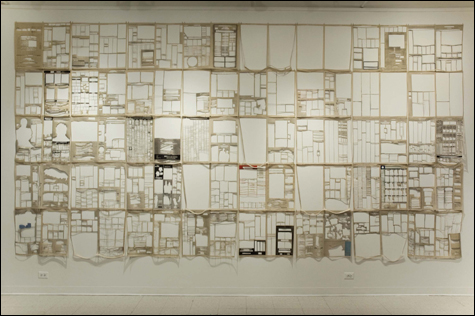
THE WORLD REDACTED: At Montserrat, Pat Shannon fills a gallery wall with dozens of New York
Times pages from which she has cut out all the type, pictures, and ads. |
“It’s Getting Hot in Here” Montserrat College of Art, 23 Essex St, Beverly | Through April 5
“Greed, Guilt & Grappling: Six Artists Respond to Climate Change”
Mills Gallery, Boston Center for the Arts, 539 Tremont St, Boston | Through March 30 |
When Al Gore won the Nobel Peace Prize last October, it was a triumph for anti-global-warming forces as well as a triumph for art. For years, scientists have struggled to focus attention on the urgent dangers of global warming, but with his film An Inconvenient Truth, Gore summed up the problem in a way that helped millions finally get it, kick-started the “green” environmentalism movement, and gave a push to government and private efforts to stem climate change.Going green has become so popular and pervasive a phenomenon — if still only beginning to produce manifestly different behavior — that it’s easy to forget how new this sea change in thinking is. Gore’s film premiered in 2006, and it quickly affected the art world, with global warming, sustainable living, and green becoming a major focus of art. In the past year or so, exhibitors have begun to round up the stuff. New shows at Montserrat College of Art in Beverly and the Boston Center for the Arts represent the two poles of green and global-warming art: inward-turning meditative gallery art and outward-reaching, simply framed activist art.
Curated by the college’s Leonie Bradbury and Shana Dumont, Montserrat’s “It’s Getting Hot in Here” addresses “how the progressive philosophy of sustainability affects art making.” The art is quiet, gentle, stylish, thoughtful, often exquisitely crafted, occasionally droll. The primary method of the eight artists is recycling, via compassionate conceptualism and crafty minimalism.
The gallery smelled earthy when I visited — the staff had just watered Vaughn Bell’s art. This Seattle artist aims to increase our sense of responsibility for the earth by presenting plants as pets: eight bowls of moss and rocks are chained to the wall with dog leashes. The responsibility theme is even more explicit in the remains of her performance from the opening night, A Pack of Forests: Land for Adoption (2008): a pair of potted ferns with sign-up forms by which visitors can “adopt” them.
Kevin Kaempf, Suraiya Hossain, and Lora Lode of the Chicago collective People Powered merge art and recycling by presenting slickly designed painting kits and Loop Limited: Recycled Paint (Montserrat) (2008), a neat stack of cans filled with recycled house paint collected from North Shore folks below a sign saying, “Please take one!”
None of the other art so directly promotes ecological responsibility or action. The materials hint that the artists may be personally concerned with the state of the world. You could say the work is about small personal changes in behavior and how they add up, but the pieces seem driven primarily by meditations on form. The resulting objects are often beautiful, but their focus can feel small, insular.